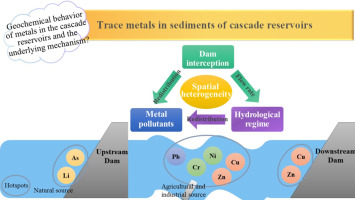Science of the Total Environment ( IF 8.2 ) Pub Date : 2020-01-27 , DOI: 10.1016/j.scitotenv.2020.136914 Yanyan Li , Bo Gao , Dongyu Xu , Wenqi Peng , Xiaobo Liu , Xiaodong Qu , Min Zhang

|
Cascade reservoirs facilitate the effective use of water resources and help to alleviate existing problems of water shortage in drought-prone regions. However, the geochemical behavior and controlling mechanisms of trace metals in response to the operation of cascade reservoirs are relatively unknown. Here, trace metals (As, Cr, Cu, Li, Ni, Pb and Zn) from ninety-eight sediment samples from the cascade reservoirs (Panjiakou and Daheiting Reservoirs) in China were evaluated. Multiple methods including geochemical baseline, geostatistical analysis, factor analysis (FA), and positive matrix factorization (PMF), were combined to assess pollution status, identify and quantify potential anthropogenic sources, and determine the influence of hydrodynamic conditions on trace metals distribution. The results indicate that minor enrichment of trace metals appeared in both cascade reservoirs. However, trace metal concentrations exhibited spatial heterogeneity between two cascade reservoirs, and diverse hotspots of different metals were unexpectedly observed. It can be explained by the following three aspects: (1) Metal hotspots were detected upstream of the cascade dams via geostatistical analysis and FA, particularly for naturally sourced metals (As and Li) where dam interception resulted in higher concentrations in the upstream reservoir. (2) PMF analysis identified agricultural, industrial, and natural sources to account for 23.44%, 41.61%, and 34.95%, respectively, to the metal concentrations in the downstream reservoir. Anthropogenic emissions were the dominant factors influencing the spatial variability of Cu, Pb, and Zn between the cascade reservoirs, with higher concentrations observed in the downstream reservoir. (3) The hydrological regime also influenced the redistribution of human-derived metals, where slower flow velocities at river bends resulted in higher deposition of metal-bearing particles. This study shed light on the spatial distribution of trace metals in response to the construction of cascade reservoirs, and it suggests that trace metal hotspots should be monitored to prevent sediment potential contamination.











































 京公网安备 11010802027423号
京公网安备 11010802027423号